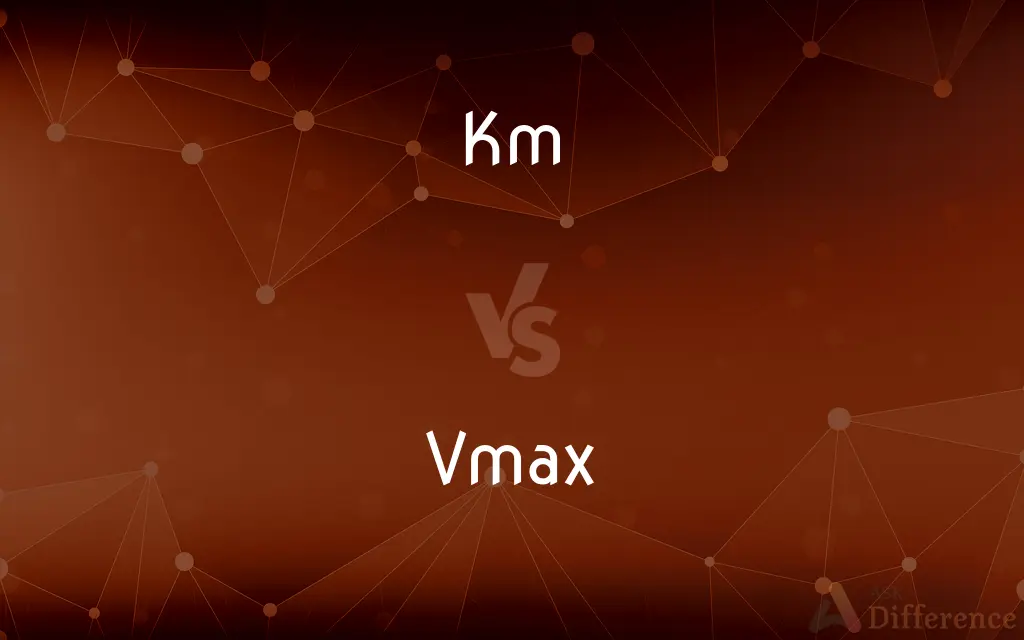Km vs. Vmax — What's the Difference?
By Tayyaba Rehman & Fiza Rafique — Published on February 17, 2024
Km is the substrate concentration at half the maximum reaction velocity (Vmax), indicating enzyme affinity. Vmax is the maximum reaction velocity, reflecting the enzyme's catalytic efficiency.

Difference Between Km and Vmax
Table of Contents
ADVERTISEMENT
Key Differences
Km (Michaelis constant) and Vmax (maximum velocity) are fundamental parameters in enzyme kinetics that describe the rate of reactions catalyzed by enzymes. Km represents the substrate concentration at which the reaction velocity is half of Vmax. It is a measure of the affinity of the enzyme for its substrate; a lower Km indicates higher affinity, meaning less substrate is needed to reach half of Vmax. This makes Km crucial for understanding how efficiently an enzyme can bind its substrate under different conditions.
Vmax, on the other hand, is the maximum rate of the reaction when the enzyme is saturated with substrate. It reflects the catalytic capacity of the enzyme and is dependent on the enzyme concentration. Vmax is a theoretical maximum that can only be approached but never reached in practical scenarios. It provides insight into the maximum efficiency of the enzyme under optimal conditions, making it a key parameter for understanding the limits of enzyme-catalyzed reactions.
The relationship between Km and Vmax is central to the Michaelis-Menten equation, which models the rate of enzymatic reactions. While Km gives information about the substrate concentration needed for significant catalysis to occur, Vmax indicates the enzyme's maximum catalytic activity. Both parameters are essential for characterizing enzymes and their interactions with substrates, as well as for designing drugs and understanding metabolic pathways.
Determining Km and Vmax experimentally helps in identifying how an enzyme might behave in different environments or how it might be inhibited by specific molecules. For instance, competitive inhibitors increase Km (decreasing substrate affinity) without affecting Vmax, while non-competitive inhibitors decrease Vmax without changing Km. This distinction is crucial for drug development, as it helps identify how drugs can modulate enzyme activity.
In summary, Km and Vmax are vital for understanding the dynamics of enzyme-catalyzed reactions. Km measures the enzyme's substrate affinity, offering insights into how easily an enzyme is activated, while Vmax indicates the enzyme's maximum catalytic efficiency. Together, they provide a comprehensive view of enzyme activity and its modulation by various factors.
ADVERTISEMENT
Comparison Chart
Definition
Substrate concentration for half-maximal velocity
Maximum possible reaction velocity
Reflects
Enzyme-substrate affinity
Enzyme catalytic efficiency
Influence by Inhibitors
Affected by competitive inhibitors
Affected by non-competitive inhibitors
Measurement
Concentration units (e.g., mM)
Velocity units (e.g., µmol/min)
Biological Implication
Lower Km indicates higher affinity
Higher Vmax indicates higher enzyme activity
Compare with Definitions
Km
Measured at half the maximum reaction velocity.
Determining Km helps understand how substrate concentration affects enzyme activity.
Vmax
Directly proportional to enzyme concentration.
Doubling the enzyme concentration doubles the Vmax.
Km
Indicator of enzyme-substrate affinity.
An enzyme with a low Km value binds its substrate more tightly.
Vmax
Decreased by non-competitive inhibitors.
Non-competitive inhibition leads to a lower Vmax without changing Km.
Km
Varied by competitive inhibition.
Competitive inhibitors increase the Km of an enzyme.
Vmax
Maximum rate of an enzyme-catalyzed reaction.
Vmax is reached when all enzyme active sites are saturated with substrate.
Km
Essential for enzyme kinetics studies.
Km values are crucial for comparing the efficiency of similar enzymes.
Vmax
Independent of substrate concentration once reached.
Beyond a certain substrate level, increases do not affect Vmax.
Km
Reflects enzyme activity under different substrate concentrations.
A high Km suggests the enzyme requires more substrate to achieve half Vmax.
Vmax
Indicator of enzyme catalytic capacity.
A higher Vmax signifies a more efficient enzyme.
Km
A metric unit of length equal to 1000 meters (or 0.621371 miles)
Common Curiosities
What does a low Km value mean?
The enzyme has high affinity for its substrate.
Why is Vmax important in enzyme kinetics?
It shows the enzyme's maximum catalytic efficiency.
Can Km change with enzyme concentration?
No, Km is independent of enzyme concentration.
What does Km stand for?
Michaelis constant, indicating substrate affinity.
How is Vmax determined?
By extrapolating reaction rates to high substrate concentrations.
Can Vmax be altered by changing substrate concentration?
No, once all enzyme sites are saturated, Vmax remains constant.
How do inhibitors affect Km and Vmax?
Competitive inhibitors increase Km; non-competitive reduce Vmax.
What role does Km play in drug design?
It helps identify how a drug can modulate enzyme-substrate affinity.
What information does Km provide about enzyme kinetics?
It indicates the substrate concentration needed for significant enzyme activity.
Is it possible to reach Vmax in a real experiment?
Practically, Vmax is approached but not reached due to limitations in substrate concentration.
What does a high Vmax indicate about an enzyme?
It suggests the enzyme can catalyze reactions efficiently.
How are Km and Vmax used in metabolic pathway analysis?
They help understand the control points and flux through pathways.
Why might two enzymes have different Km values for the same substrate?
Differences in active site affinity due to structural variations.
Can Vmax be affected by temperature or pH?
Yes, as these factors influence enzyme structure and activity.
How do Km and Vmax relate to enzyme specificity?
Km reflects specificity by indicating how readily an enzyme binds a substrate, while Vmax shows the extent to which the enzyme can catalyze the reaction.
Share Your Discovery

Previous Comparison
POSB vs. DBS
Next Comparison
Dyad Muscle vs. Triad MuscleAuthor Spotlight
Written by
Tayyaba RehmanTayyaba Rehman is a distinguished writer, currently serving as a primary contributor to askdifference.com. As a researcher in semantics and etymology, Tayyaba's passion for the complexity of languages and their distinctions has found a perfect home on the platform. Tayyaba delves into the intricacies of language, distinguishing between commonly confused words and phrases, thereby providing clarity for readers worldwide.
Co-written by
Fiza RafiqueFiza Rafique is a skilled content writer at AskDifference.com, where she meticulously refines and enhances written pieces. Drawing from her vast editorial expertise, Fiza ensures clarity, accuracy, and precision in every article. Passionate about language, she continually seeks to elevate the quality of content for readers worldwide.
















































